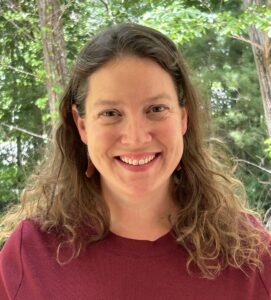Navigating Pathways to Teaching in the U.S. with Aspiring Educators of Refugee and Immigrant Backgrounds

By Sarah Bracken,
Senior Project Associate,
Center for Professional Learning

By Sarah Bracken,
Senior Project Associate,
Center for Professional Learning
In a recent interview, Pathways to Teaching Project Fellow Mary R. (not her real name) shared this message for refugees and immigrants who were teachers in their home countries and who aspire to teach in the United States:
Any new person who comes, I would encourage them to stick to their profession, not to look for small things or small jobs, not to have that mentality of saying ‘as long as it lets me survive’. No, they should go for the best. Keep following their dreams!
Mary was referring to the tendency of many newly arriving refugees and immigrants to take whatever job they can find quickly to pay the bills and meet requirements for remaining in the country, even if the job does not connect with the individual’s assets, desires, or past work experience.
About 35% of immigrants over the age of 25 have earned a bachelor’s degree or higher from a country outside of the United States, a rate that is similar for U.S.-born adults. Before being forcibly displaced, many refugees and immigrants held professional jobs, including in education.
When these former classroom teachers, school administrators, and program directors resettle in or immigrate to the United States, many are ready and eager to share their knowledge and skills with their new communities. But the path to teaching can seem blocked in every direction, with obstacles that appear impossible to move past.
Prerequisites that feel normal to prospective teachers who grew up in the U.S. — a university degree, a practicum, a license — can pose unique challenges to refugees and immigrants, even those with significant experience in education outside of the U.S.
A few reasons why entering a pathway to teaching can be daunting for newcomers include:
Refugees and other immigrants may possess a degree and significant experience in education, but they must also pass exams and eventually teach in English.
For some, this is a small hurdle. For others, it is a formidable obstacle that can take years to overcome. Many believe they must be absolutely fluent in English before they can apply for a job, but research shows that multilingualism in the classroom is an asset for students and teachers alike.
Refugees and immigrants in the U.S. face the daunting challenge of navigating new systems.
This may include making phone calls to HR departments, writing emails to certification and licensing entities, and filling out applications with terminology that may or may not be familiar. Additionally, refugees and immigrants have to learn about how U.S. education systems work, with great variety between states and districts, and how their new country talks about and values the role of education in people’s lives.
Many new applicants may feel overwhelmed and even discouraged by the paperwork, skills, and knowledge required to navigate different systems just to get started in their chosen profession.
Most educators with international degrees and teaching experience have to first pay for their transcripts to be translated and evaluated, and then they often need to earn a new teaching certificate in the United States.
Attending and paying for a one or two-year teacher certification program can be overwhelming when you first arrive in a new country – oftentimes with very little money or security net – and are working full time, taking care of a family, and learning a new language and culture.
There are also refugees who have advanced degrees but cannot get official transcripts from their former universities. One example from our recent project includes an Afghan woman who earned bachelor’s and master’s degrees before the Taliban seized power in 2021. When she requested her official transcript after resettling in the U.S., the university told her that as a woman, under the new laws, her degree was not valid and would therefore not be released. Another Pathways to Teaching Fellow earned a degree at a university that was subsequently reorganized after a regime change. Official documents were lost.
Some of the issues outlined above pose significant challenges. Language barriers, missing transcripts, and program costs, for example, will likely require prospective educators to invest substantial time and money to move forward along their path.
But some of the obstacles are, fortunately, more navigable than they may have first appeared. Over a period of about nine months, the Center for Professional Learning team at Childhood Education International facilitated the Pathways to Teaching Project to support prospective teachers of refugee and immigrant backgrounds both in choosing a pathway to teaching and then in moving past certain obstacles along that path with guidance, collaboration, creativity, and persistence.
These prospective teachers (called Fellows) first participated in a facilitated online course that introduced them to aspects of the U.S. education system such as school structure, professional expectations, social and emotional learning, and culturally responsive and sustaining pedagogies. The goal was not only to provide a foundation in U.S. education systems, but also to support Fellows in connecting their experience and desires to an education career in their new country.
Throughout the project, Fellows continued to build their knowledge — and education lexicon — through English language sessions and workshops on teaching approaches, job skills, technology in education, and self-care. Fellows had opportunities to connect with current educators also from refugee and immigrant backgrounds who shared stories of their own unique pathways to teaching because sometimes seeing someone with a similar background reaching a similar career goal can build confidence in one’s ability to pursue their own dreams.
As the Fellows’ more specific goals emerged, they worked with project mentors to develop individualized pathway plans. Together, they navigated systems at the state and local/district levels to find both realistic and hopeful opportunities for moving forward.
Perhaps most importantly, this community of practice became a network of friendship and support for everyone involved. Project participants and supporters alike learned from each other and found ways to connect around hopes, dreams, and goals — both personal and in support of a stronger U.S. education system. As Mary and many other Fellows expressed in interviews, the Pathways to Teaching Project made them believe that they could do it – that becoming a teacher in the U.S. was possible.
The teacher shortage in the United States is impacting many schools and communities, and we at Childhood Education International believe that a well-trained, diversified workforce — including multicultural and multilingual educators who can connect with diverse students on a deep and nuanced level — is one of the keys to reducing this shortage. Attracting and retaining culturally and linguistically diverse educators will require a shift in how school districts recognize and leverage the assets that people who are newly arriving in this country can bring to the classroom.
Each of the Fellows who participated in the inaugural Pathways to Teaching cohort taught me something — how to persist through extraordinary challenges, how to start as strangers and leave as friends, how to learn a new language, how to teach in ways that are different from what I learned in my teacher preparation program.
And the Fellows’ feedback confirms that they learned a lot, too — about U.S. education systems, about career options in their local district or state, and about their own assets and resources as they move forward on their pathway to a teaching career in the U.S.
Ultimately, this kind of program highlights why it is so important for districts to consider candidates like those in our first community of practice around Pathways to Teaching initiatives. The Fellows bring multicultural perspectives, multilingual superpowers, determination, resilience, and an authentic desire to learn and to support all children and youth in the classroom. I am honored to have walked alongside each of them on one part of their unique pathway to teaching, and I cannot wait to see how they help to reshape education in the United States in the future.
And if you were wondering, Mary begins her job as a 4th grade lead teacher in an elementary school in Washington, D.C., this fall. We wish her a fabulous year!
 Sarah Bracken, Senior Project Associate, Center for Professional Learning
Sarah Bracken, Senior Project Associate, Center for Professional LearningSarah Bracken is a Senior Project Associate with the Center for Professional Learning at Childhood Education International. She loves collaborating with other educators and aspiring teachers to co-create inclusive, equitable, and joyful schooling systems where students of refugee and immigrant backgrounds can thrive.
Before joining CE International, Sarah was a secondary teacher and instructional coach working mostly with newcomer students and families in Washington state, Maryland, Virginia, and Alaska. Originally from Baltimore, Maryland, Sarah now calls Asheville, North Carolina, home. She tries to play outside every day with her family.
Childhood Education: Innovations is a bimonthly magazine dedicated to sharing unique, interesting, and stimulating information from schools and learning environments around the world. Whether you are facing specific challenges in your work or simply want to stay informed about the most recent ideas and innovations in childhood education, you will find inspiration and ideas in this education publication.
Articles can be accessed by paying a one-time download fee per article using the links below, or by subscribing. Subscribers receive new issues and access to more than 100 years of back issues.
The Journal of Research in Childhood Education is an academic journal the presents peer-reviewed education research on a wide range of ideas, including theory articles and studies on all scales. From empirical research projects to small-case studies carried out in naturalistic settings, such as schools and community centers, articles track data across cultures and study research design.
Articles can be accessed by paying a one-time download fee per article using the links below, or by subscribing. Subscribers receive new issues and access to back issues.
Childhood Education International is dedicated to ensuring that displaced, refugee, and (im)migrant children and youth have access to quality, holistic education for that builds on their strengths, supports their needs, and offers opportunities to build bright futures.
The Center for Professional Learning supports educators and other education leaders working in refugee displacement, migration, crisis, and resettlement contexts around the world.
Recent highlighted projects include: